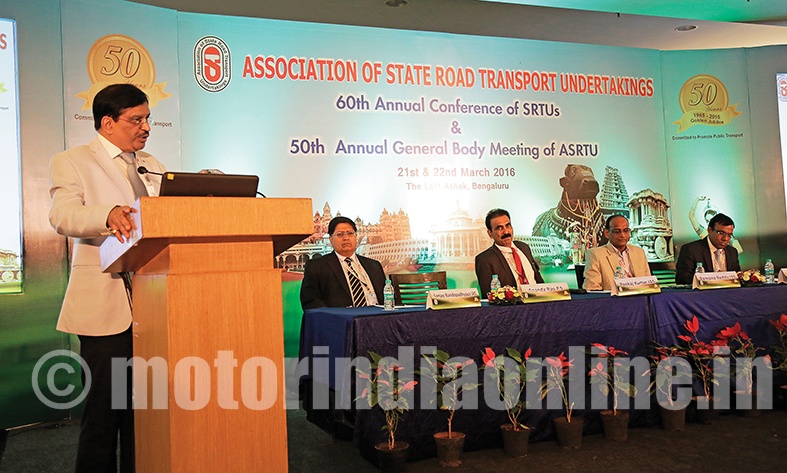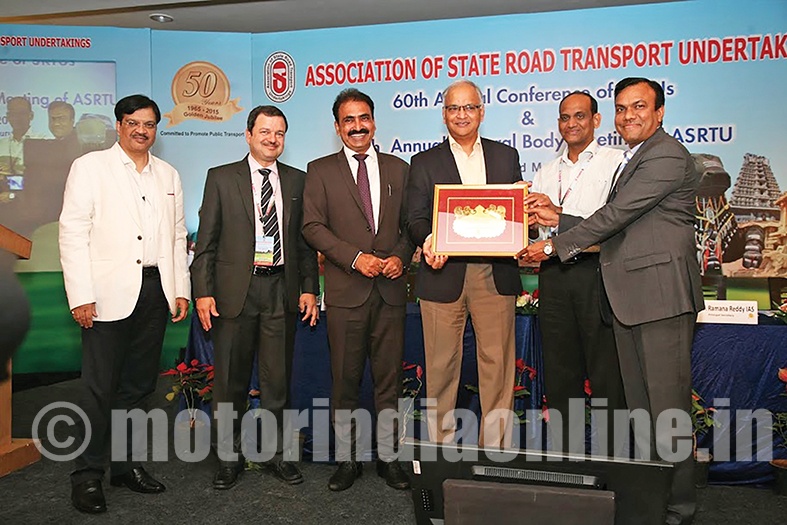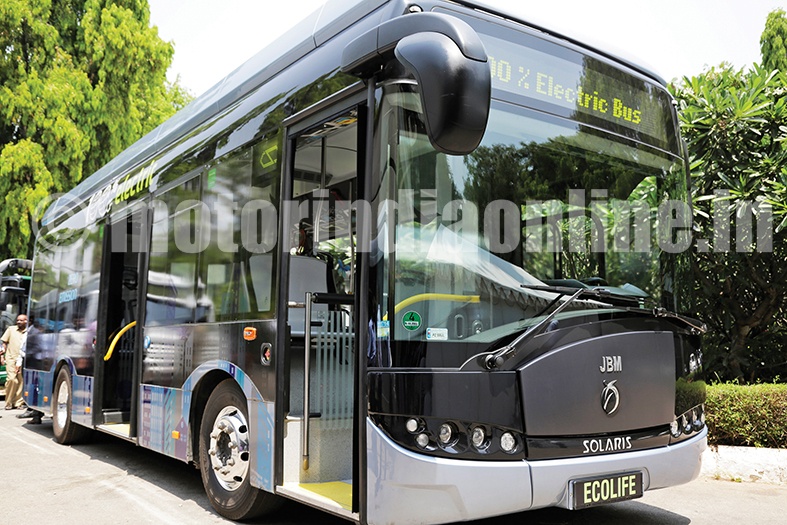A sage once rightly said that churning first produces bitterness and then the cream. The two-day conference organized by the Association of State Road Transport Undertakings (ASRTU) with support from the Karnataka State Road Transport Corporation (KSRTC) on March 21-22 in Bengaluru proved to be exactly that, ending up with the cream of better understanding of challenges and possible solutions to the problems of the 60 plus STUs.

The conference, held to mark the 60th annual conference of the SRTUs and the 50th AGM, saw the crucial participation of STU heads from across the country, including Jammu & Kashmir and Sikkim, and Government officials from the transport sector. Intense deliberations were held on the challenges faced by STUs, their financial instability and common hurdles like embracing information technology, opting for alternative and less polluting fuel or keeping their overheads low. The most important issue that was discussed was the fate of STUs as declared by the latest Road Transport and Safety Bill.
The conference also witnessed the launch of the first 100 per cent biodiesel bus in the country by KSRTC, unveiling of ‘Innovation in Bus Technology – The ASRTU Approach’ – a book, and giving away of ASRTU Transport Excellence Awards for the first time in its history.
Survival strategy
In a country where distances less than 750,000 km are covered by road, meaning SRTUs carry three times more passengers than railways daily, it is ironical that merely two-three STUs make profit.
Mr. Rajender Kumar Kataria, MD, KSRTC, explained: “More than 40 per cent of our operations happen to remote areas as part of our social obligations and we incur huge losses. Instead of being given special status to receive support, subsidy or protection from the government, the chapter in the proposed Road Transport and Safety Bill that provided us the privileges has been withdrawn. When it comes to public versus private interest, it’s always them who are taken care of.”
Mr. Ranjit Singh Deol, VC & MD, Maharashtra SRTC, which runs 18,000 buses, echoed the sentiment: “The clandestine operation is a major challenge. Not only do we have to compete with them but also have to take care of 1.10 lakh employees since its welfare work.”
The solution to survival lies in becoming more professional, reworking strategies to wean people away from private to mass transport, shared Mr. Abhay Damle, Jt. Secretary (Transport), MORTH: “The second draft of the Road Safety Bill, released in July 2015, has no mandate for STU privatization. Everything has been left to the States.”
Pointing out the incongruity of STUs plying non-profit routes while being treated as commercial organizations, the GSRTC VCMD, Mr. Pankaj Kumar, said: “We pay income-tax so we are commercial organization, but tell me which commercial organization runs welfare measures for the State Government and is not compensated for that? We seek a level playing field.”
The way ahead for STUs lies in working out own policy and becoming part of the planning process. Acting as a spontaneous arbitrator, Mr. Arvind Jadhav, Chief Secretary (Transport), Government of Karnataka, pointed out: “The Government depends upon the heads of the STUs to act as policy advisors whether on rural or urban connectivity. You must have local bodies involved in the decision making process. Take Rome, London, Singapore or Perth. The local urban bodies are involved and provide subsidies because public road transport is a civic amenity. But if you lord over them, then you will be told to pay for it.” Indeed a tall order!

Financial woes
Since their birth, the STUs consistently have had a sour taste in their mouths – in the form of losses. They are plagued by huge overheads, whether of maintenance or of employee salaries, pensions and perks on par with the Central Government pay scales.
Mr. Pankaj Kumar rued the fact: “Credit rating of the STUs will allow them to look for alternate avenues for financing because the State Government is not kind towards us.”
On the other hand, Mr. K. Ravinder Naik, MD, UPSRTC, questioned: “The Government mandates for all the buses to be fitted with speed governance, CCTVs and GPS worth Rs. 4,000 crores. Why should the RTCs incur this? The Government should fund this, if not fully at least partially.”
Adding another layer, the RSRTC’s CMD, Mr. Rajesh Yadav, said: “I have hired EY consultants to help turn around RSRTC from making losses to profits or a break-even point.”
The story of smaller STUs like the Puducherry RTC is no different, lamented the MD, Mr. K Kumarakrishnan: “We may have to cut the steady increase in the employee salaries to manage overheads.”
The J&KSRTC MD, Mr. G.A. Sofi, said: “Our fleet of 600 buses is old and needs to be replaced. But it’s strange that we don’t get the aid like GSRTC which receives Rs. 700 crores from its State Government.” The sentiment, echoed by other STUs as well, received instructions to pursue their respective State Governments for aid from the GSRTC head.
Info Tech Churner
It’s high time that the STUs embraced IT to efficiently manage their fleets. Take for example TNSRTC in Kumbakonam which plies 3,800 buses but has not adopted IT yet. According to Mr. Ananda Rao, not all the STUs are convinced on IT front. On its part, ASRTU helps them by facilitating pilot programs for better understanding of the technicalities, and by sharing investment funds.
Another aspect which received overall support from the members was that receiving time bound tests analyses. It was felt that the adequacy of testing institutes like NATRiP, CIRT and others be reviewed. Mr. Kataria said: “I get reports after I have already consumed the material. If there is a negative report, the testing organization should share it immediately.”
The CIRT Director, Mr. Ashish Misra, shared: “The challenge, besides the time taken in testing different samples, is that for getting the rate contract with ASRTU, the supplier may give good material, but what he actually supplies to the STUs must be monitored. The STUs are supposed to send random samples to us for testing, but not all of them do it and not very regularly.”
Word of caution
If STUs were to tighten their professional belts, the churning would be less. Foreseeing trouble ahead, Mr. Jadhav cautioned the STUs: “Technology will be one big challenge for you. Metro, high speed trains, urban, elevated or underground transport – all will be competition to you. The STUs must know how to meet the challenge.”
In the proverbial sense, the STUs are all geared to churn till the cream is obtained.
“KSRTC launched 100% biodiesel bus, the first of its kind in the country.”
– Mr. Rajender Kumar Kataria, MD – KSRTC
“Air-road-rail connectivity is required for seamless travel.”
– Mr. Arvind Jadhav, Chief Secretary (Transport), Government of Karnataka
“STUs not in good shape, need support.”
– Mr. Pankaj Kumar, CMD – GSRTC
“Only around 2 per cent citizens use public transport daily. It is not a healthy sign for a developing country.”
– Mr. Abhay Damle, Jt. Secretary (Transport), MORTH
“We will work to pre-empt the pollution problem.”
– Mr. Lok Nath Sharma, Jr. GM – MIS, Government of Sikkim
“RTUs have many assets but their monetization is lacking.”
– Mr. N Sambasiva Rao, VCMD – APSRTC
“CIRT tests thousands of samples. Delay must be happening on one or two.”
– Mr. Ashish Misra, Director – CIRT
“UPSRTC will be closer to Rs. 40 crores of profits by March 2016.”
– Mr. K Ravinder Naik, MD – UPSRTC
“NATRIP is setting up Rs. 4000 crores worth of testing and R&D facilities in India”
– Mr. Sanjay Bandhopadhyay, CEO – NATRiP
“Our app helps consumers track the bus movements and availability of seats beforehand”
– Mr. Antony Chacko, MD – Kerala SRTC
“The future role of the STUs vis-à-vis private players needs to be discussed with the MORTH”
– Dr E V Ramana Reddy, Principle Secretary (Transport), Government of Karnataka
“It’s not about profits but sustainability”
– Mr. P S Ananda Rao, Executive Director – ASRTU
